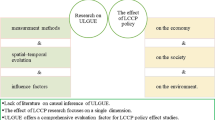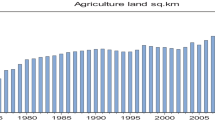Abstract
It is crucial for the development of carbon reduction strategies to accurately examine the spatial distribution of carbon emissions. Limited by data availability and lack of industry segmentation, previous studies attempting to model spatial carbon emissions still suffer from significant uncertainty. Taking Pudong New Area as an example, with the help of multi-source data, this paper proposed a research framework for the amount calculation and spatial distribution simulation of its CO2 emissions at the scale of urban functional zones (UFZs). The methods used in this study were based on mapping relations among the locations of geographic entities and data of multiple sources, using the coefficient method recommended by the Intergovernmental Panel on Climate Change (IPCC) to calculate emissions. The results showed that the emission intensity of industrial zones and transport zones was much higher than that of other UFZs. In addition, Moran’s I test indicated that there was a positive spatial autocorrelation in high emission zones, especially located in industrial zones. The spatial analysis of CO2 emissions at the UFZ scale deepened the consideration of spatial heterogeneity, which could contribute to the management of low carbon city and the optimal implementation of energy allocation.







Similar content being viewed by others
Data availability
The datasets used during the current study are available from the corresponding author on reasonable request.
Abbreviations
- UFZ:
-
Urban functional zone
- IPCC:
-
Intergovernmental Panel on Climate Change
- LMDI:
-
Logarithmic mean Divisia index
- LEAP:
-
Long-range Energy Alternatives Planning
- DMSP-OLS:
-
Defense Meteorological Satellite Program–Operational Linescan System
- NPP-VIIRS:
-
National Polar-orbiting Operational Environmental Satellite System Preparatory Pro Visible Infrared Imaging Radiometer Suite
- POI:
-
Point-of-interest
- OSM:
-
OpenStreetMap
- ESDA:
-
Exploratory spatial data analysis
- LISA:
-
Local Indicators of Spatial Association
- ID:
-
Industrial zone
- TS:
-
Transport zone
- RS:
-
Residential zone
- CT:
-
Cultural tourism zone
- CS:
-
Commercial service zone
- PS:
-
Public service zone
References
AbdelRahman MAE et al (2021) Assessment of land degradation using comprehensive geostatistical approach and remote sensing data in GIS-model builder. Egypt J Remote Sens Space Sci 22(3):323–334
Ahmed J et al (2022) Urban air pollution caused of particulate matter and lead in the City of Chittagong-Bangladesh. Am J Environ Sci Eng 6(1):7–15
Chen L, Qi Q, Wu H et al (2023) Will the landscape composition and socio-economic development of coastal cities have an impact on the marine cooling effect? Sustain Cities Soc 89:104328
Chen Y et al (2022) A GloVe model for urban functional area identification considering nonlinear spatial relationships between points of interest. ISPRS Int J Geo-Inf 11(10):498
Gan L et al (2022) Regional inequality in the carbon emission intensity of public buildings in China. Buil Environ 225:109657
Gao N, Li F (2021) Spatial quantitative analysis of urban energy consumption based on POI and night-time remote sensing data. Int J Econ Energy Environ 6(6):164–173
Gong W et al (2023) Analysis of urban carbon emission efficiency and influencing factors in the Yellow River Basin. Environ Sci Pollut Res Int 30(6):14641–14655
Gong Y, et al (2022) Assessing changes in the ecosystem services value in response to land-use/land-cover dynamics in Shanghai from 2000 to 2020. Int J Environ Res Public Health 19(19)
Gurney, K et al (2020) The vulcan version 3.0 high‐resolution fossil fuel CO2 emissions for the United States. J Geophys Res-Atmos 125(19):e2020JD032974
Hu G, Ma X, Ji J (2019) Scenarios and policies for sustainable urban energy development based on LEAP model – A case study of a postindustrial city: Shenzhen China. Appl Energy 238:876–886
Huynh LH et al (2017) Developing a high-resolution melting method for genotyping and predicting association of SNP rs353291 with breast cancer in the Vietnamese population. Biomed Res Therapy 4(12):1812–1831
Ji J, Lin H (2022) Evaluating regional carbon inequality and its dependence with carbon efficiency: implications for carbon neutrality. Energies15(19)
Jing Y, Sun R, Chen L (2022) A method for identifying urban functional zones based on landscape types and human activities. Sustainability 14(7):1430
Li W et al (2022) Spatiotemporal evolution of county-level land use structure in the context of urban shrinkage: evidence from Northeast China. Land 11(10):1709
Li Y, Shen J, Xia C et al (2021) The impact of urban scale on carbon metabolism–a case study of Hangzhou, China[J]. J. Clean Prod 292:126055
Liu H et al (2022) Identification of relative poverty based on 2012–2020 NPP/VIIRS night light data: in the area surrounding Beijing and Tianjin in China. Sustainability 14(9):5599
Muntean M et al (2014) Trend analysis from 1970 to 2008 and model evaluation of EDGARv4 global gridded anthropogenic mercury emissions. Sci Total Environ 494–495:337–350
Mir KA et al (2021) Comparative analysis of greenhouse gas emission inventory for Pakistan: part II agriculture, forestry and other land use and waste. Adv Clim Chang Res 12(1):132–144
Narit Y, Sithichai L, Benjavan R (2016) Carbon storage in mountain land use systems in Northern Thailand. Mt Res Dev 36(2):183–192
Oda T, Maksyutov S (2011) A very high-resolution (1 km×1 km) global fossil fuel CO2 emission inventory derived using a point source database and satellite observations of nighttime lights. Atmos Chem Phys 11(219):543–556
Piotr H, Zbigniew N (2015) Emission data uncertainty in urban air quality modeling—case study. Environ Model Assess 20(6):583–597
Qingyu Q, Oh KK (2021) Exploring the characteristics of high-speed rail and air transportation networks in China: a weighted network approach. J Int Logist Trade 19(2):96–114
Tao W, Kai Z, Keliang L et al (2023) Spatial heterogeneity and scale effects of transportation carbon emission-influencing factors—an empirical analysis based on 286 cities in China. Int J Environ Res Public Health 20(3):2307
Upadhyay S et al (2021) Spatio-temporal variability in soil CO2 efflux and regulatory physicochemical parameters from the tropical urban natural and anthropogenic land use classes. J Environ Manag 295:113141
Wang P et al (2017) Analysis of energy consumption in Hunan Province (China) using a LMDI method based LEAP model. Energy Procedia 142:3160–3169
Wang L et al (2022a) Stackelberg game-based optimal scheduling of integrated energy systems considering differences in heat demand across multi-functional areas. Energy Rep 8:11885–11898
Wang G, Han Q, de Vries B (2019) Assessment of the relation between land use and carbon emission in Eindhoven, the Netherlands. J Environ Manag 247:413–424
Wang SH, Huang SL, Huang PJ (2018) Can spatial planning really mitigate carbon dioxide emissions in urban areas? A case study in Taipei, Taiwan. Landsc Urban Plan 169:22–36
Wang T et al (2023) Spatial heterogeneity and scale effects of transportation carbon emission-influencing factors—an empirical analysis based on 286 cities in China. Int J Environ Res Public Health 20(3):2307
Wang X et al (2022b) Carbon emission accounting and spatial distribution of industrial entities in Beijing—Combining nighttime light data and urban functional areas. Eco Inform. 70:101759
Wang Z et al (2017) Monitoring evolving urban cluster systems using DMSP/OLS nighttime light data: a case study of the Yangtze River Delta region, China. J Appl Remote Sens 11(04)
Xia C, Dong Z, Wu P et al (2022) How urban land-use intensity affected CO2 emissions at the county level: Influence and prediction[J]. Ecol Indic 145:109601
Xia C, Zhang J et al (2023) Exploring potential of urban land-use management on carbon emissions–A case of Hangzhou, China[J]. Ecol Indic. 146:109902
Xia S, Yang Y (2022) Examining spatio-temporal variations in carbon budget and carbon compensation zoning in Beijing-Tianjin-Hebei urban agglomeration based on major functional zones. J Geogr Sci 32(10):1911–1934
Xiaowei C, Jianxi F (2019) High resolution carbon emissions simulation and spatial heterogeneity analysis based on big data in Nanjing City, China. Sci Total Environ 686:828–837
Xu R et al (2021) Magnitude and uncertainty of nitrous oxide emissions from North America based on bottom-up and top-down approaches: informing future research and national inventories. Geophys Res Lett 48(23):e2021GL095264
Yang R, Hu Z, Hu S (2023) The failure of collaborative agglomeration: from the perspective of industrial pollution emission. J Clean Prod 387:135952
Yang T et al (2022) An estimating method for carbon emissions of China based on nighttime lights remote sensing satellite images. Sustainability 14(4):2269
Yang Y, Li H (2022) Monitoring spatiotemporal characteristics of land-use carbon emissions and their driving mechanisms in the Yellow River Delta: a grid-scale analysis. Environ Res 214(P4):114151
Zeng L et al (2022) The carbon emission intensity of industrial land in China: spatiotemporal characteristics and driving factors. Land 11(8):1156
Zhang Q et al (2022) Using multi-source geospatial information to reduce the saturation problem of DMSP/OLS nighttime light data. Remote Sens 14(14):3264
Zhang Y et al (2021) Spatial-temporal characteristics and decoupling effects of China’s carbon footprint based on multi-source data. J Geogr Sci 31(3):32614–32627
Zheng Y et al (2022) Estimating carbon emissions in urban functional zones using multi-source data: a case study in Beijing. Build Environ 212:108804
Zhenyue L, Jinbing Z, Pengyan Z et al (2023) Spatial heterogeneity and scenario simulation of carbon budget on provincial scale in China. Carbon Balance Manag 18(1):20
Zhou K et al (2023) Spatial and temporal evolution characteristics and spillover effects of Chinaʼs regional carbon emissions. J Environ Manag 325(PA):116423
Zhou N (2022) Research on urban spatial structure based on the dual constraints of geographic environment and POI big data. J King Saud University-Sci 34(3):101887
Zhao J, Shao Z, Xia C et al (2022) Ecosystem services assessment based on land use simulation: A case study in the Heihe River Basin, China[J]. Ecol Indic 143:109402
Zhu E et al (2022) The spatial-temporal patterns and multiple driving mechanisms of carbon emissions in the process of urbanization: a case study in Zhejiang, China. J Clean Prod 358:131954
Zhu E et al (2023) Spatiotemporal coupling analysis of land urbanization and carbon emissions: A case study of Zhejiang Province, China. Land Degrad Dev 34:4594–4606
Funding
This research was supported by the National Natural Science Foundation of China (No. 72104139) and (No.71972128).
Author information
Authors and Affiliations
Contributions
EZ wrote the manuscript and offered funding to support the research. JY wrote the manuscript and created the tables and figures. XZ collected and analyzed the data. LC provided experimental guidance. All the authors have read and approved the final manuscript.
Corresponding author
Ethics declarations
Ethics approval
Not applicable.
Consent to participate
Not applicable.
Consent for publication
Not applicable.
Competing interests
The authors declare no competing interests.
Additional information
Responsible Editor: V.V.S.S. Sarma
Publisher’s Note
Springer Nature remains neutral with regard to jurisdictional claims in published maps and institutional affiliations.
Rights and permissions
Springer Nature or its licensor (e.g. a society or other partner) holds exclusive rights to this article under a publishing agreement with the author(s) or other rightsholder(s); author self-archiving of the accepted manuscript version of this article is solely governed by the terms of such publishing agreement and applicable law.
About this article
Cite this article
Zhu, E., Yao, J., Zhang, X. et al. Explore the spatial pattern of carbon emissions in urban functional zones: a case study of Pudong, Shanghai, China. Environ Sci Pollut Res 31, 2117–2128 (2024). https://doi.org/10.1007/s11356-023-31149-5
Received:
Accepted:
Published:
Issue Date:
DOI: https://doi.org/10.1007/s11356-023-31149-5




